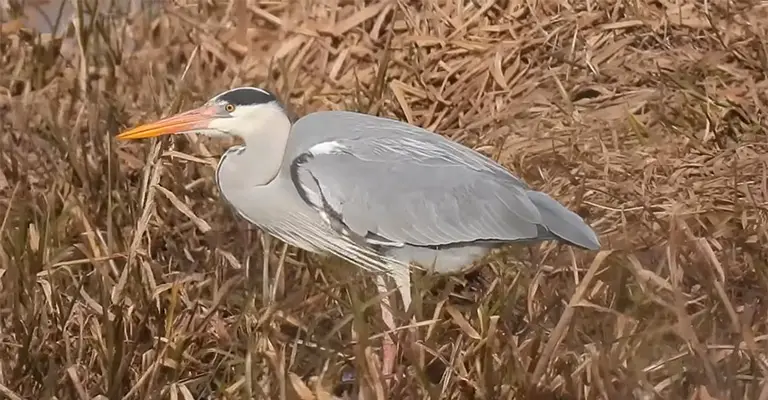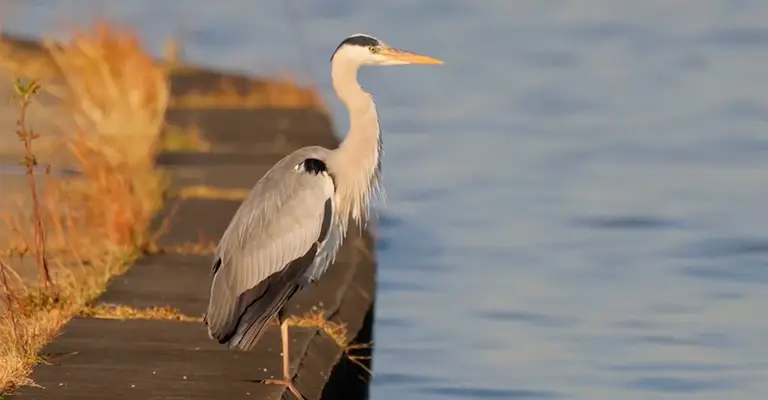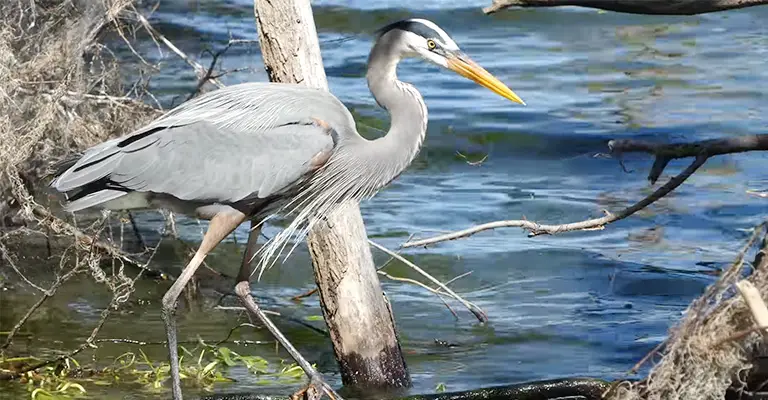Previously, we learned about the birds that move during winter. But, is blue heron one of them? Do blue herons migrate?
Ardea herodias, commonly known as the great blue herons are beautiful majestic birds. They are genuinely known for their towering stature, long necks, and impressive fishing skills. Yes, they love fish a lot!
They are often found in wetlands, marshes, and along the shores of rivers, lakes, and coastal areas.
As we talked about migration before, we came to know birds move in search of food and habitat for a limited time. But does the blue heron join them too? We will soon learn it today, but not until we reach the end of our article.

Migratory Behavior of Blue Heron
The blue herons are migratory or not! It generally depends on the geographical and environmental scenario. They often exhibit a mix of migratory and sedentary behavior, with their migratory pattern affected by different factors such as seasonal changes, temperature, and food availability.
Where Do Blue Herons Live Year-Round?
The Blue Herons are year-round habitats of warm regions where water doesn’t freeze during the winter. There, they have access to a consistent food supply, primarily fish and other aquatic creatures.
Examples of such regions include parts of the southern United States, Central America, and South America including the Galapagos. Blue herons who are found in these regions usually don’t need to migrate in search of food or warmer temperatures.
Do Blue Heron Migrate?

The blue herons are partially migratory. Meaning, not the entire community but only a part of them are migrate. Some areas are temperate where winter is relatively milder.
In regions like this, only a part of the community moves. They may move shorter distances to find open water and food. The partial migration allows them to adapt to changing conditions without undertaking long journeys.
Usually, blue herons from the North United States and Canada migrate during the winter. They travel from higher latitudes (which is their breeding ground) to warm regions.
However, some of them can migrate long distances to the South of Central America.
South or North? Where Do the Blue Herons Go?
In the northern parts of America where winters are harsh and water bodies freeze, the Great Blue Herons have full migration. They embrace full migratory journeys to seek suitable wintering grounds with open water and abundant food.
They usually go to the southern United States, Mexico, and Central America from February to April. And when do they migrate south?
Between mid-September and to end of October, the great blue herons migrate south from the northern parts. It generally happens during the early of August.
Routes the Blue Herons Take

The migratory routes of Great Blue Herons usually depend on their breeding locations. Herons from eastern North America migrate along the Atlantic Flyway, while those from western North America follow the Pacific Flyway.
The herons also take breaks in between their journey, just like we humans do. The migration corridor provides suitable stopover locations and wintering grounds.
Atlantic Flyway:
Herons who breed in eastern Canada and the northeastern United States often migrate along the Atlantic coast. They follow the coastline southward to their wintering destinations in the southeastern United States, the Gulf Coast, and parts of the Caribbean.
Destination: Southeastern United States, the Gulf Coast, and some Caribbean islands.
Pacific Flyway:
Some Herons breed in western Canada and the western United States. They migrate along the Pacific coast and head south to winter in regions such as California, Mexico, and Central America.
Destination: California, Mexico, and Central American countries.
Central Flyway:
This highway is for the Herons who breed in the central and western regions of North America. This flyway includes the central part of North America and offers various wetland habitats and rivers for rest and feeding during migration.
Destination: The southern United States, Mexico, and Central America.
Mississippi Flyway:
Different parts of America are breeding regions for the great blue herons. Some of them breed in the central and north-central regions of North America.
The Mississippi Flyway route follows the Mississippi River valley, providing suitable stopover sites along the riverbanks and wetland areas.
Destination: Different parts of the southeastern United States and the Gulf Coast.
Here are the common routes the blue herons follow. Remember that, not all Great Blue Herons migrate. Some herons may remain year-round, making them non-migratory or partial migratory residents.
Potential Threats the Blue Herons May Face
It’s not too uncommon for the Great Blue Herons, like many migratory birds, to experience challenges and threats during their migratory journeys.
One of the most significant threats to Great Blue Herons is the loss of their wetland habitats. Urban development, agriculture, and infrastructure projects often dominate the vital areas. Ultimately, urbanization reduces the availability of suitable foraging and breeding sites.
Additionally, Climate Change can impact their ability to find suitable rest and feeding areas along their migration routes. It can also disrupt their suitable timing for migration and limit the availability of open water in wintering grounds.
Plus! Don’t forget about us! We are the major culprit to disturb their natural living.
Our activities, such as recreational boating, fishing, and photography, can disturb the nesting colonies, ultimately resulting in nest abandonment, and reducing the success rate at breeding. Noise, pollution, and habitat alteration also contribute to such degradation.
But, we shouldn’t stop. By addressing the challenges collectively, we can ensure that Great Blue Herons continue to grace our wetlands and waterways for generations to come. After all, it’s their world too.
Last Words
Are you a responsible bird enthusiast? Then, it’s already our duty to ensure a safe breeding ground as well as migratory grounds for the blue herons.
As they live near us, we shouldn’t be too selfish and help them out to safely travel and live. Because they migrate partially, we can easily help them grow and feel safe in their own territory.
Do you like our article? Feel free to share with your friends and let them know about us. Also, leave a comment below and let us know what you think of the migration style of the great blue herons.